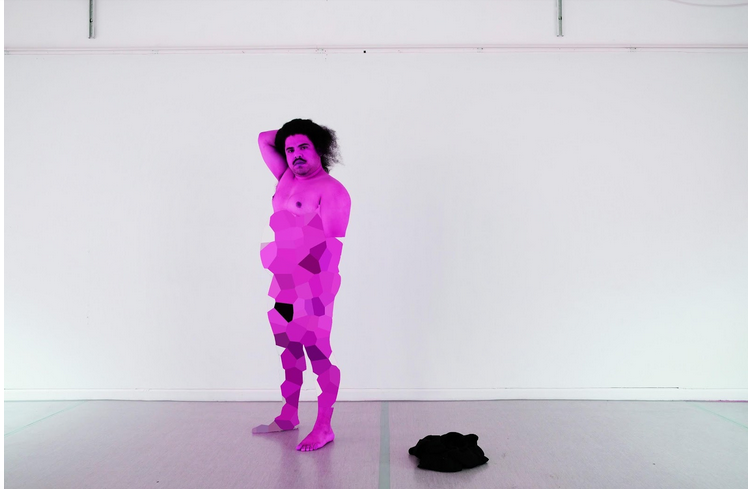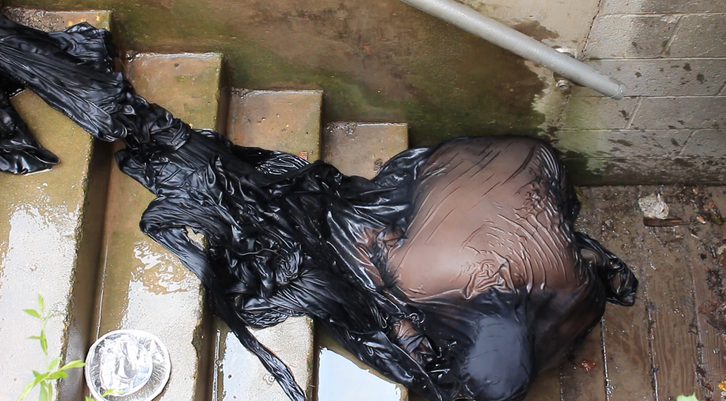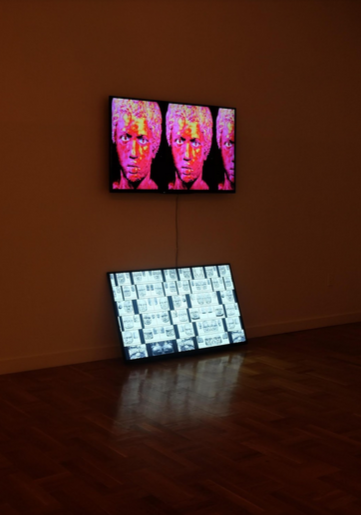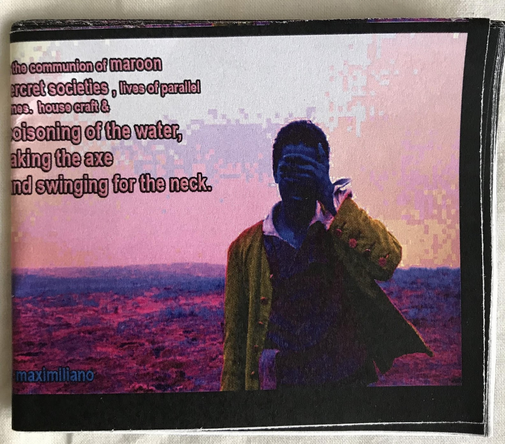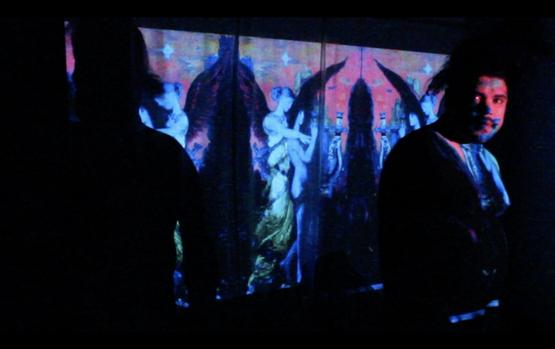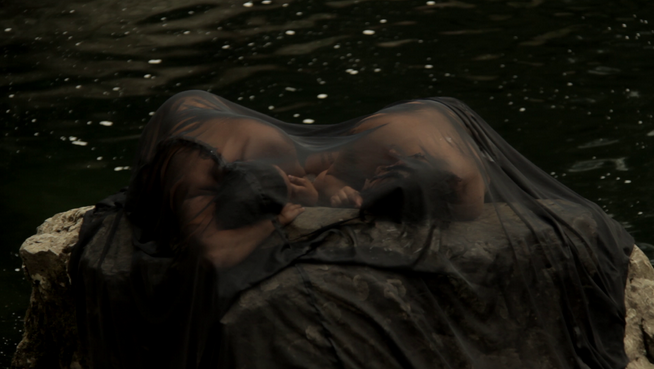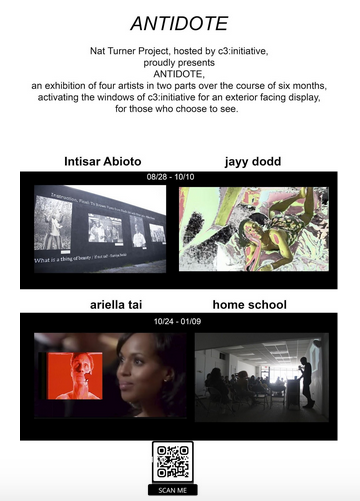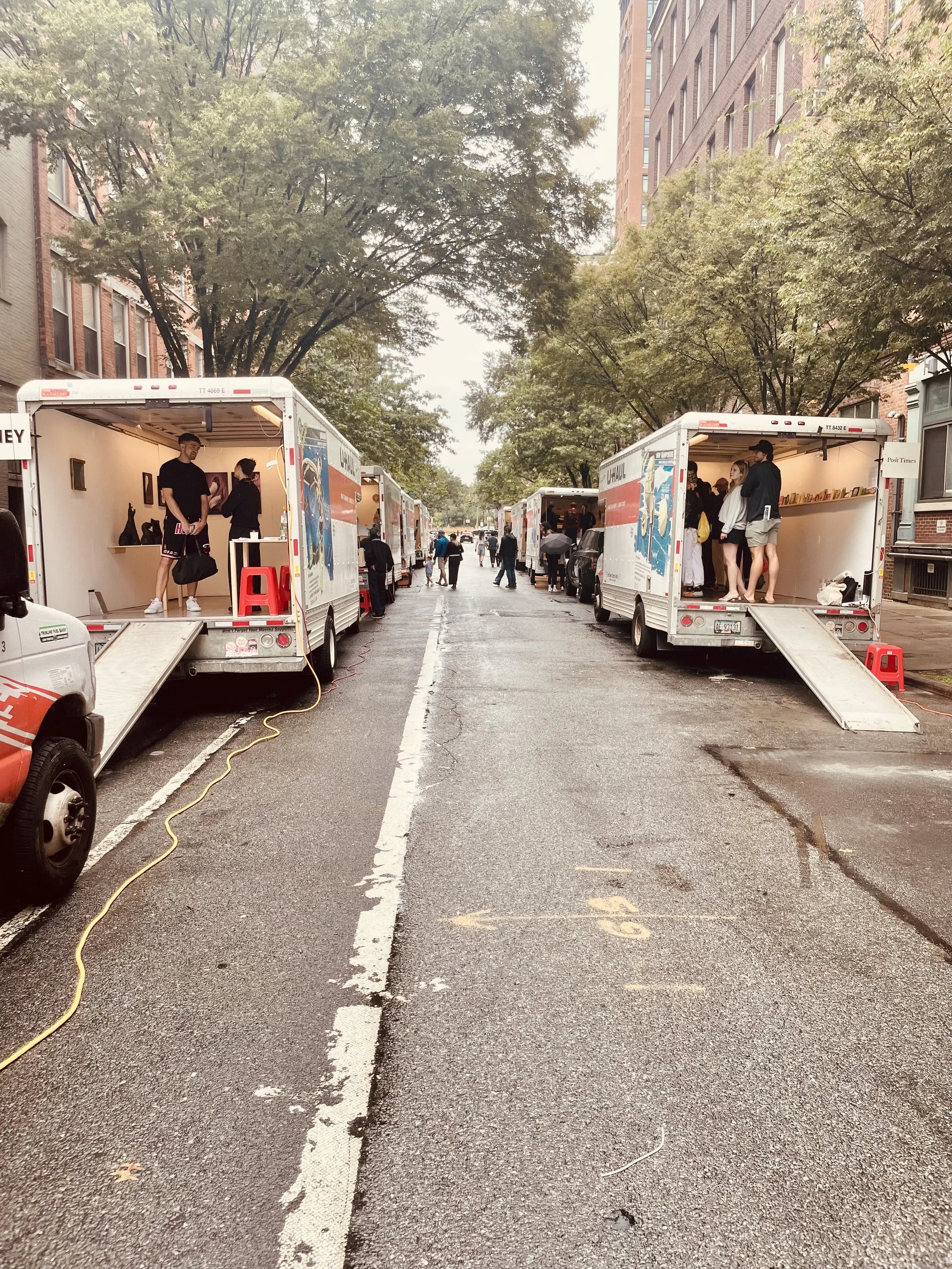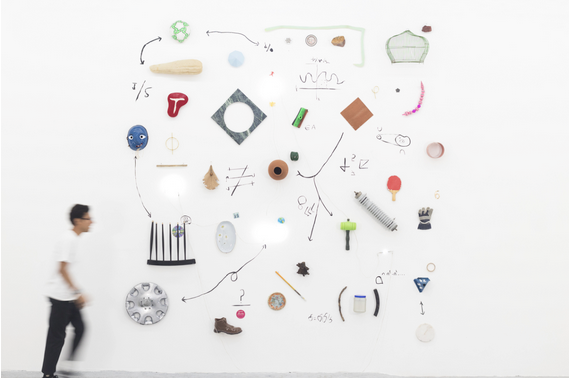the briefness of things and multiple forms: An Interview with maximiliano
maximiliano speaks directly and sparsely, even, about their multifaceted artistic practice. The brevity is poetic, leaving room for breath, for embodiment, for psychic space. In February 2020, we met at Hilt, a bar in East Portland, and talked for a few hours about the slippage among forms that guides their work. What follows is an interview over Google Docs dipping in and out of these forms.
maximiliano, self-portrait test X0901, July/August 2020, digital edit, dimensions variable.
Laurel V. McLaughlin (LM): You’re currently an Alembic Artist-in-Residence at Performance Works NorthWest, and while this residency might look a bit different due to COVID-19, I’m hoping you can share what you’re working on.
maximiliano (m): Yes, I’m an Alembic Resident. The residency has been different with COVID. I’ve been working on a couple different things: a Regional Arts & Culture Council Project Grant-funded multimedia performance since the end of last year, and have been working on it at PWNW since June. It was going to be one thing pre-COVID, but now will be something else, a lot more fluid. It’s ANDROIDS IN THE TOWER, which will be a video piece, a visual poem publication & clothing, and a publication. I have been working on it with Onyx Andra as the co-performer. The Critical Review is going to be written by Melanie Stevens, keyon gaskin is the Dramaturg and with Alejandra Arias Sevilla as Technician. The publication, Critical Review, and clothing come out Oct 26th, 2020. The visual poem as video screening will be November 20th, 2020.
I have been working on solo experimentation around “taste” and confronting “taste.” I’m also still and always thinking about “brief states,” the briefness of things. It’s my first time to have access to that kind of space, with that amount of room, lighting, projector, and speakers. It’s been great to craft, create, and think about these resources for performance, which is new for me.
LM: I’m curious how you’re thinking of performance within the context of video, especially based on this evocative image from your work in progress above. And then I’m hoping that you can also share more about your conceptions of “taste” and how you’re confronting it.
m: Yeah, the camera is the viewer, and then the viewer is anonymous, when posted online. I’d prefer, for sure, to stand there with a full audience, staring at each other, holding that space, holding that moment, but with the world at the moment it's all humanless. The lack of body, right? I do think of video as a freedom compared to live performance, the ability to lie or edit, to manipulate reality and truth in ways live performance does not allow, from bodied, to unbodied. Especially now with people consuming video on the computer versus in person installations or screenings. More peeking into the fish tank than falling in the ocean.
In crafting a performance, in thinking about art, in thinking about what actions are available, what’s obscene, what’s “too much” or what’s for shock and not relevant to the art. Then having that moment of, where do those ideas even come from?! It’s all subjective. How did I decide what was appropriate and inappropriate? Especially within art. Then I feel an anger, a passion against these notions placed into my mind by others. From parents, to peers, and art professors, their ideas of taste, but like—fuck that. I need to challenge all notions within myself, because everything was put there by others, I’m suspicious of all my thoughts and am now taking stock of them and eliminating all limitations, all that does not serve me, all that only seeks to limit what’s possible by taste. Fuck taste.
maximiliano, DRWN CITIES live performance at Pittsburgh Performance Art Festival, August 26–27, 2017. Photography by Alex Beddell.
maximiliano, GHOSTS & VENUS (installation view), 2018. Two-channel visual poem. Installation view: Littman Gallery, Portland State University, October 4–28, 2018. Photography by Kalaija Mallery.
maximiliano, THE COMMUNION OF MAROON SECRET SOCIETIES, LIVES OF PARALLEL TIMES, HOUSECRAFT & POISONING OF THE WATER, TAKING THE AXE AND SWINGING FOR THE NECK., 2019. Visual poem publication, 4 x 3 in.
LM: During our studio visit in November of 2019, we discussed the numerous forms of your artistic practice, such as performance, video, zine, sculpture, collaboration, and curation—some of which are seen in the images above. How do these multiple forms sit together in your practice?
m: I see them all as different tools to explore and express. They sit on top of each other, sometimes elbowing, sweating, and breathing heavy over each other. A lot of the time, the work of one medium becomes a generative starting point for work in another medium.
LM: You mentioned that experience and ritual were aspects that were central to your practice. How do you view these terms and how do they figure in your work?
m: I think experience is your effect on matter and matter’s affect on you. Yeah, I think it is about belief and intention, engaging that matter, communing with and potentially collaborating with it.
Yeah, ritual. I believe in magic and the mutability of the universe. I think ritual is a template for that. When we first spoke, ritual was still an active participant in my thoughts and making, but now it has receded from the foregrounds of my explorations. I think ritual now is preparation, if apocalypse is revelation, then the ritual is prepping to witness, and the opposite, to prepare to be the thing that is witnessed. The source of the revelation. Ritual was charging spaces and bodies, loops and flesh, circles of water, of bodies, but now it’s an empty room, a post-charged circle, like post-performance.
maximiliano, blvk GVLVHVD (still), 2019. Video, 22:43 min.
LM: Turning to a few works, we talked about blvk GVLVHVD, 2019, in which you perform within a Pacific Northwest forest, collaborating with a black veil. Eventually the frame of the video resituates you in other digital and physical spaces. You characterized the work as video, or a visual poem; could you talk about the form and then the work more broadly?
m: A visual poem can exist in a variety of media, as moving or still image. Named so from my desire of how I want to present the work, and for how I want it to be viewed/read, sat with.
blvk GVLVHVD is about black innocence, lamentation of black innocence. What is purity in the context of blackness? Refuting whiteness notions of youth, innocence, purity, and virtue. It’s about Spolia Opima. It’s about the Holy Grails, whatever your Grail is. The reclamation of black innocence, of black imagination, the goal of black liberation. It’s about attempts and quests.
Spolia Opima, is the noblest spoils, the truest spoils from ancient Rome. Spolia Opima was attained when the Roman general in command of the army, slew, in single combat, the rival general of an enemy army. The Roman would then take the sword and shield of the fallen adversary and dedicate them to the temple of Jupiter back in Rome. It was considered the highest honor in ancient Rome, mythical. According to the histories, it was only ever achieved by three people throughout the 1000+ year history of Rome. It was this unattainable goal, this challenge that would haunt the heads of young roman princes seeking glory and immortality.
Isn’t ambition a vice not a virtue? A thing to be shamed in some, encouraged in others? Even deeper than that is, want, or desire. About desires, about being desired, wanting to be desired.
maximiliano, Jaleesa Johnston, rubén garcía marrufo, rise x fall (still), 2018–present. Performance, dimensions variable.
LM: You’ve also been collaborating with Jaleesa Johnston and rubén garcía marrufo on rise x fall since 2017. How does this collaboration build upon the themes and practices you’ve developed in the previous works we’ve mentioned?
m: We’ve been working together since 2017. Jaleesa and I had conceptual crossovers in blackness, blackness in relation to water, and using our own nude bodies in performance—that's the wellspring from which rise x fall flows. And rubén being able to film and capture our actions, hauntings.
I’d say the above work builds more on themes and practices of rise x fall (which I don’t think we even had a name for our collaboration until our 2018 Spaceness performance). It has been instrumental to my individual practice in so many different ways and definitely a factor in where I am currently and with my recent work. rise x fall is slow moving and a recurrence of veiled bodies, which is echoed in many of my individual works, but I think rise x fall is haunting me and my work as much as it is haunting spaces. It’s a different loop outside of time, that we come back to, but feels like before and after.
Press Release Image of ANTIDOTE, NAT TURNER PROJECT, exhibition August 28, 2020–January 9, 2020, hosted by c3:initiative.
LM: And finally, you’ve developed significant curatorial and collaborative work through NAT TURNER PROJECT. Could you share more about this organization, your role, how it aligns with your practice, and its recent efforts?
m: Yes, NAT TURNER PROJECT is a black radical fugitive art “space” / collaboration between Melanie Stevens and myself, focusing on paying and supporting Black & POC artists in Portland. Over the years we have facilitated and curated exhibitions, we have multiple publications NAT TURNER PROJECT : TESTIMONY a catalog of our first year of curation, and Offal, a critical zine comprising work from four scholars. More recently we began a grant fellowship, DRINKING GOURD FELLOWSHIP—no strings attached micro-grants given to Black & POC artists in the Portland Area. We have given out grants ranging from $250–$1000— and we currently create a podcast series WHO ALL GON BE THERE .
NTP has also been collaborating with A BLACK ART ECOLOGY OF PORTLAND (BAEP, SHARITA TOWNE) on a couple different things, RELIEF PROGRAMME where we raise and disperse funds, and the BLACK ABBEY RESIDENCY—organized and initiated by Sharita Towne and with NTP brought on to aid. Six Black artists from Portland were given access to different spaces at Alberta Abbey and a stipend, to create work or use the space however they wanted. The residency was held this summer, June–August, 2020, at the Alberta Abbey, and participating artists were Ella Ray, Nichole Robinson, Jaleesa Johnston, Mikai Arion, and manuel arturo abreu. There will also be a BLACK ABBEY publication coming soon and it will be available for purchase.
LM: What is next for you?
m: I will be a part of this year’s TBA 2020 with rise x fall screening work in progress ii a video edit of our in progress materials. NAT TURNER PROJECT has ANTIDOTE up currently and until January 2021.
My RACC-funded project, ANDROIDS IN THE TOWER, is coming! October 26th & November 26th!
ig @androidsinthetower.
ABOUT:
mononymously named, maximiliano is a black chicanx conceptual artist currently working in performance, video, GIF, thought, sculpture, zines, and collaboration. a BLKwvv mythos of reclamation rococo.
Laurel V. McLaughlin is a curator and art historian from Philadelphia, currently based in Portland, OR. McLaughlin holds M.A.s in the History of Art from The Courtauld Institute of Art and Bryn Mawr College, and is presently a Ph.D. Candidate at Bryn Mawr College and ACLS/Luce Dissertation Fellow writing a dissertation concerning “performative migratory aesthetics” in works by womxn-identifying practitioners in the United States, 1970s–2016. Her writing has appeared in Art Papers, Art Practical, Performa Magazine, Title Magazine, Antennae: The Journal of Nature in Visual Culture, and Performance Research, among others, and she has co-curated exhibitions and programs at the Pennsylvania Academy of the Fine Arts, FJORD Gallery, AUTOMAT Gallery, Vox Populi. She is currently organizing a forthcoming exhibition, Networks of (Be)longing at the Center for Contemporary Art & Culture at the Pacific Northwest College of Art, October 16–December 6, 2020 that is accompanied by a satellite solo exhibition of the work of Rami George, and one day will tell you so many stories, at Paragon Arts Gallery, on view through November 15, 2020.


